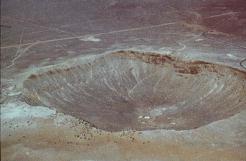
Barringer Meteor Crater; Arizona. It's about 50,000 years old.
Photo by NASA
As illuminated earlier, most of the meteors don't make it past the atmosphere because they're too small to withstand the disintegration.
Those that are large enough to survive become subject to gravity before impacting the Earth.
At ground level, the acceleration (a) due to gravity is defined as: a = -g = -9.8 m/s2. (It's negative because it's falling towards the center of the Earth.)
The acceleration when it first enter the Earth, however, is considerably lower, the jerk (change in acceleration) increases as the meteor comes closer to the ground.
The gravitational acceleration (ag) is the acceleration of an object falling towards Earth at vary altitude (h). And m is the mass of the object.
The equation for this is: ag=Gm/r2. This describes the different accelerations at different altitudes.
Eventually, the meteoroid will reach terminal velocity (vt).
vt=sqroot(2mg/CρA), where C=drag coefficient, ρ=density of object, and A=cross-sectional area.
For larger meteoroids, it travels farther before reaching its terminal velocity.
When the meteoroid hits the ground, some--if not all--of the meteoroid breaks apart on impact.
Whatever rock remains is a meteorite. Depending on the size of the meteoroid and the velocity, it can also produce a crater.
The size of the crater depends on the size of the asteroid, the velocity with which it struck, and the angle in which it hit.
This is related to energy. The kinetic energy of any object is shown as: E=(1/2)mv2.
To take the angle (θ) of approach into account, we take the sin of the angle to fully realize its vertical energy.
So we get: E=(1/2)mv2sinθ for the energy for which the meteor strikes.
So ultimately, a larger meteoroid will produce a bigger crater.
There are numerous meteoroid impacts on Earth, but few of them are big enough to cause concern or to create large craters.
<--In the Atmosphere Home Bibliography-->